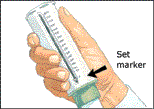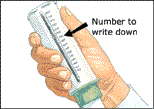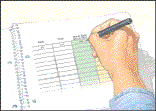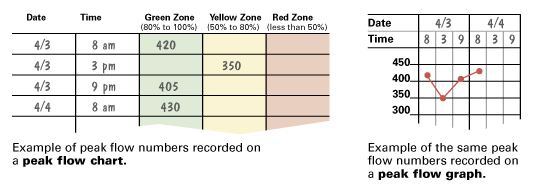Using a Peak Flow Monitor
Peak Flow Monitoring
Monitoring your peak flow can help tell you how open your airways are—even before you have symptoms. It's done with a device called a peak flow meter. Your peak flow is how fast you can push air out of your lungs at any one time. Regular monitoring tells you how well your treatment plan is working. Your health care team will tell you when and how often to measure your peak flow. Be sure to write down your results. Take the results with you when you visit your health care team.
Following are the steps for using a peak flow meter
How to Use a Peak Flow Meter
1. Set the meter
Move the marker to 0, or to the lowest number on the scale.
Stand. (If you can't stand, be sure to sit up straight.) Make sure you're in the same position each time you test.
2. Blow into the mouthpiece
Take as deep a breath as you can.
Put the mouthpiece of the meter in your mouth, between your teeth. Close your lips tightly around it. Be sure your tongue does not block the opening.
Blow into the mouthpiece once, as hard and as fast as you can.
3. Read the meter
Take the meter out of your mouth.
Look at the marker. It will have moved along the numbered scale. Write this number down.
Move the marker back to 0, or to the lowest number on the scale.
4. Record your results
Repeat the test two more times.
Write the highest of the three numbers on your chart or in your diary. This is your peak flow number.
Using Peak Flow to Find Your Asthma Zones
Ask a member of your health care team to provide the peak flow numbers for your asthma zones. Use these numbers as a guide when you measure your peak flow. Always follow your special action plan for the zone you're in.
Your Asthma Zones
Your personal best peak flow number is ___________.
___________ is your green zone. This range is 80% to 100% of your personal best.
Action: Keep following your daily treatment plan.
___________ is your yellow zone. This range is 50% to 80% of your personal best.
Action: Take the medications suggested in your action plan. Get away from your triggers.
___________ is your red zone. This range is less than 50% of your personal best.
Action: Take your quick-relief medication and any other medications your action plan suggests.
Then talk to your health care provider right away or go to the hospital. Call 911 (emergency) instead if you are struggling to breathe, can't walk or talk because of shortness of breath, or your lips or fingernails are turning blue.
Keeping Track of Your Peak Flow Numbers
When you monitor your peak flow, you need to write down the highest of the three numbers you get (your peak flow number). You may want to use a chart or a graph. The examples here are for someone who monitors peak flow three times a day.
Updated:
March 21, 2017
Reviewed By:
Chris O'BrienChris O'Brien RN MPH,Cineas, Sybil MD




